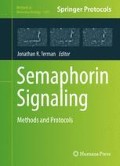Abstract
Semaphorin guidance molecules act through different receptor complexes to activate multiple signaling cascades leading to changes in axonal growth cone behavior and morphology. We describe here approaches for studying the effect of individual Semaphorins on isolated forebrain neurons from mouse embryos and dissecting downstream signaling pathways. These approaches include the production of recombinant Semaphorin ligands, the culture of dissociated primary neurons, the manipulation of gene expression by electroporation in primary neurons, and functional assays to assess axon outgrowth and growth cone collapse.
Access this chapter
Tax calculation will be finalised at checkout
Purchases are for personal use only
References
Pasterkamp RJ (2012) Getting neural circuits into shape with semaphorins. Nat Rev Neurosci 13:605–618
Yoshida Y (2012) Semaphorin signaling in vertebrate neural circuit assembly. Front Mol Neurosci 5:71
Kantor DB, Chivatakarn O, Peer KL et al (2004) Semaphorin 5A is a bifunctional axon guidance cue regulated by heparan and chondroitin sulfate proteoglycans. Neuron 44:961–975
Chauvet S, Cohen S, Yoshida Y et al (2007) Gating of Sema3E/PlexinD1 signaling by neuropilin-1 switches axonal repulsion to attraction during brain development. Neuron 56:807–822
Bellon A, Luchino J, Haigh K et al (2010) VEGFR2 (KDR/Flk1) signaling mediates axon growth in response to semaphorin 3E in the developing brain. Neuron 66:205–219
Flanagan JG, Cheng HJ (2000) Alkaline phosphatase fusion proteins for molecular characterization and cloning of receptors and their ligands. Methods Enzymol 327:198–210
Adams RH, Lohrum M, Klostermann A et al (1997) The chemorepulsive activity of secreted semaphorins is regulated by furin-dependent proteolytic processing. EMBO J 16:6077–6086
Christensen C, Ambartsumian N, Gilestro G et al (2005) Proteolytic processing converts the repelling signal Sema3E into an inducer of invasive growth and lung metastasis. Cancer Res 65:6167–6177
Varshavsky A, Kessler O, Abramovitch S et al (2008) Semaphorin-3B is an angiogenesis inhibitor that is inactivated by furin-like pro-protein convertases. Cancer Res 68:6922–6931
Kutschera S, Weber H, Weick A et al (2011) Differential endothelial transcriptomics identifies semaphorin 3G as a vascular class 3 semaphorin. Arterioscler Thromb Vasc Biol 31:151–159
Copeland WH, Nealon DA, Rej R (1985) Effects of temperature on measurement of alkaline phosphatase activity. Clin Chem 31:185–190
Deck M, Lokmane L, Chauvet S et al (2013) Pathfinding of corticothalamic axons relies on a rendezvous with thalamic projections. Neuron 77:472–484
Meijering E, Jacob M, Sarria JC et al (2004) Design and validation of a tool for neurite tracing and analysis in fluorescence microscopy images. Cytometry A 58:167–176
Bagnard D, Lohrum M, Uziel D et al (1998) Semaphorins act as attractive and repulsive guidance signals during the development of cortical projections. Development 125:5043–5053
Niquille M, Garel S, Mann F et al (2009) Transient neuronal populations are required to guide callosal axons: a role for semaphorin 3C. PLoS Biol 7, e1000230
Acknowledgments
We thank Axelle Dovonou for providing pictures of collapsed growth cones. The authors’ research is funded by Centre National de la Recherche Scientifique (CNRS), Aix-Marseille Université, grant from Agence Nationale de la Recherche (ANR-12-BSV4-0012-01) to F.M., and Institut Universitaire de France to S.C.
Author information
Authors and Affiliations
Corresponding author
Editor information
Editors and Affiliations
Rights and permissions
Copyright information
© 2017 Springer Science+Business Media New York
About this protocol
Cite this protocol
Chauvet, S., Mire, E., Mann, F. (2017). Characterizing Semaphorin Signaling Using Isolated Neurons in Culture. In: Terman, J. (eds) Semaphorin Signaling. Methods in Molecular Biology, vol 1493. Humana Press, New York, NY. https://doi.org/10.1007/978-1-4939-6448-2_16
Download citation
DOI: https://doi.org/10.1007/978-1-4939-6448-2_16
Published:
Publisher Name: Humana Press, New York, NY
Print ISBN: 978-1-4939-6446-8
Online ISBN: 978-1-4939-6448-2
eBook Packages: Springer Protocols

